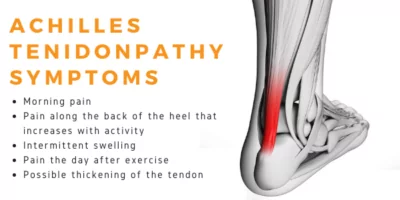The term "Achilles tendinopathy" (common overuse injury) describes a collection of pathological alterations affecting the Achilles tendon, which are typically brought on by overuse and excessive chronic stress. Both athletes and non-athletes exhibit it. These injuries are more likely to occur if your Achilles tendon is rigid or lacks flexibility.
Achilles tendinopathy can be a very frustrating condition to have. What begins as a little pain might develop into discomfort that lasts for months and prevents you from engaging in your preferred activity. Fortunately, a significant majority of patients with Achilles tendinopathy recover with conservative care.
Achilles Tendinopathy: What is it?
Tendinitis and tendinosis, two disorders that affect tendons, are frequently referred to collectively as tendinopathy. While tendinosis is a degenerative disorder brought on by repeated mishandling, on the other hand, tendinitis is an acute inflammatory state of the tendon.

Risk Factors Associated With It:
A number of the risk factors for achilles tendinopathy are under our control. These include stress, poor nutrition, sleep deprivation, and overuse. In this article, we'll talk about the risk factor of overloading the achilles tendon, which can happen either all at once or repeatedly over time.
This emphasises the necessity of balancing our workloads and the significance of rest. Depending on where a tendonopathy is located in the body, it will have a distinct impact. For instance, the achilles tendon will become more malleable while the patellar tendon would often get stiffer.
Aches and pains in the achilles tendon: Diagnostic ultrasonography or MRI is presently the gold standard for achilles tendinopathy diagnosis. However, there are indicators that this illness is present, such as signs and symptoms.
Achilles tendon discomfort that is localised: Achilles tendon painS after a day of excessive use (especially in the morning) and increasing achilles tendon stress causes more pain. You should speak with a physical therapist or a doctor who specializes in sports medicine because other problems can appear similarly to achilles tendinopathy.

Achilles Tendinopathy Treatment
`
Here’s what should be done:
Stress should be momentarily taken from the achilles tendon. Reduce or discontinue the achilles tendon-damaging activity. Give it time to mend so you can proceed with the proper progressions.
Wearing shoes with a heel raise helps the achilles tendon to be shortened as a result, which will lessen the repetitive stress that walking places on it.
Avoid extending the achilles tendon. The objective is not to increase range of motion because, as tendinopathy typically makes the achilles tendon more malleable.
Put the tendon under deliberate stress. The greatest evidence for recovery, refers to moderate loading of the Achilles tendon. As a result, the muscle and tendon are strengthened, enhancing their capacity to withstand tension.
High degrees of resistance should eventually be applied to provide the best prospects for recovery.
Keep an eye on your pain levels during exercise, taking care not to go over a limit pain while engaging in exercise. Before confidently exercising through pain, it's crucial to obtain a proven diagnosis of achilles tendinopathy.

Here’s what you should know !
Early to midphases of recovery from insertional tendinopathy should avoid a heavy dorsiflexed position since this can compress the tendon. When they are aggravated, tendon often do not respond well to compression.
The tendon will eventually need to bear some compression in this dorsiflexed posture as it is a necessary component of function, but doing so too soon with tendinopathy can cause the symptoms to continue.
Working through a dorsiflexed position normally does not make mid-portion Achilles tendinopathy worse. With mid-portion Achilles tendinopathy, you can perform calf raises off a step considerably sooner, and these cases tend to be more common.

Conclusion:
It can take up to 12 weeks for tendon tissue to fully recover and adapt. Keeping this time frame in mind can help you avoid pushing yourself too hard too soon and aggravating your symptoms. It doesn't necessarily mean that it will take this long until you start to feel better.
On the other hand, not doing enough will leave the tissues frail and vulnerable to further damage. If you repeatedly commit either of these errors, it can become a persistent problem. As with most ailments, it's important to train to enhance leg and trunk biomechanics and function. This will lessen the erroneous forces that are applied to the

You can determine the ideal quantity of work to complete within a given time frame to treat Achilles tendinopathy and return to your favorite activities by having a physical therapist monitor your case.
When it comes to starting this, however, it is critical to consult with a doctor first. Failure to do so may result in an injury or illness, which may result in a setback. Once that is cleared, it is time to take the first step toward resuming a fit lifestyle, one that will most likely last much longer than a sedentary one.
If you or someone you love is suffering from this, you should consult expert physiotherapists to get rid of the strain. Physiotherapists at fit o fine use cutting-edge advanced practices that include but are not limited to the use of massages, movements, and exercises. Make an appointment with us so that one of our therapists can discuss the best treatment option for you.
